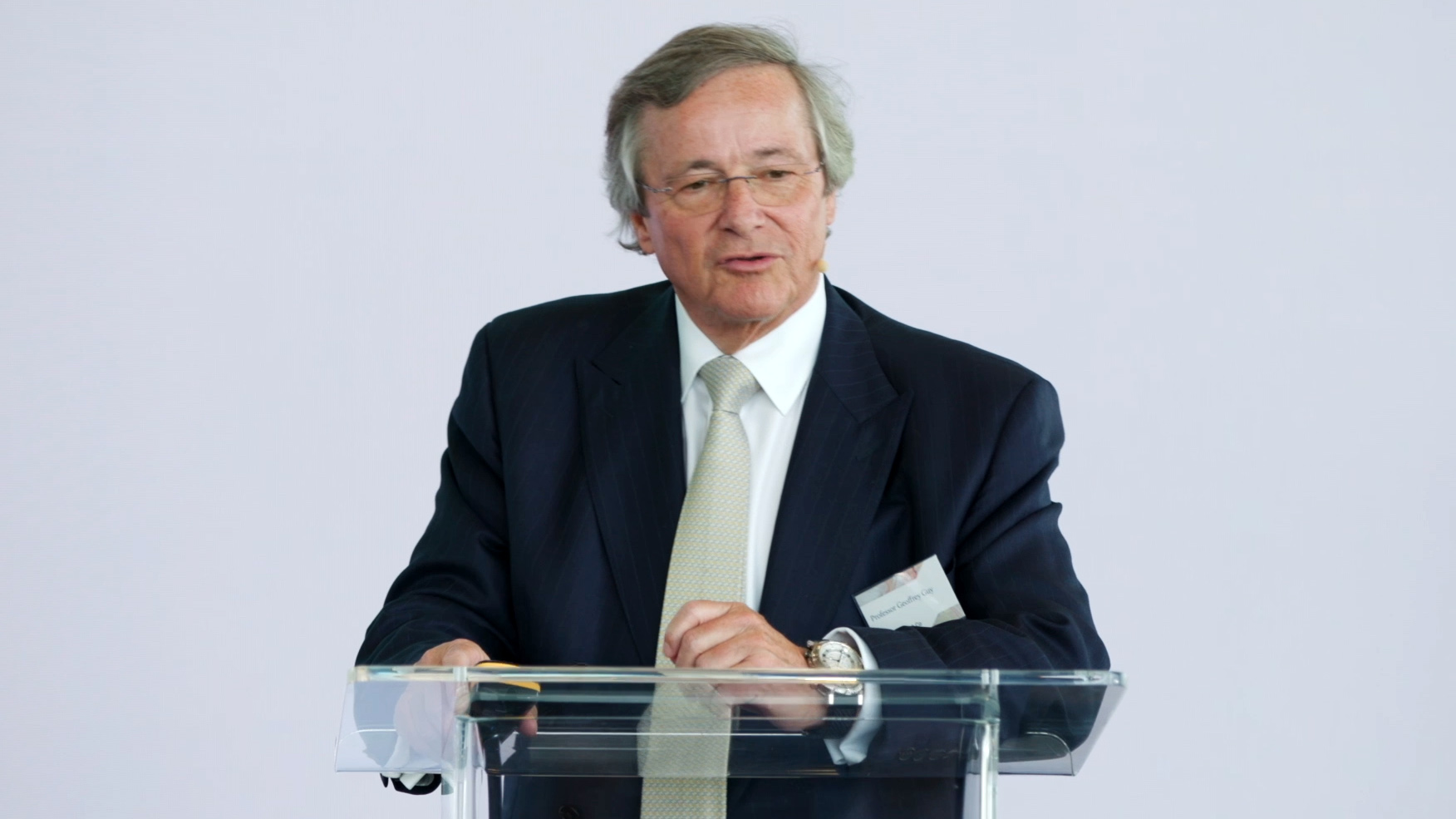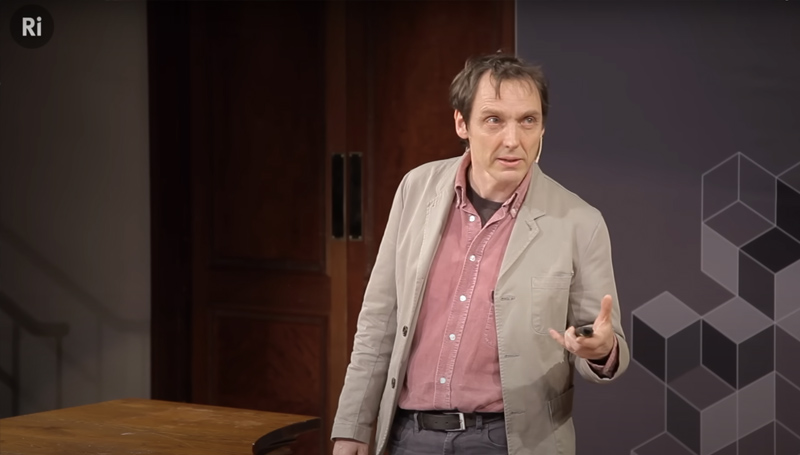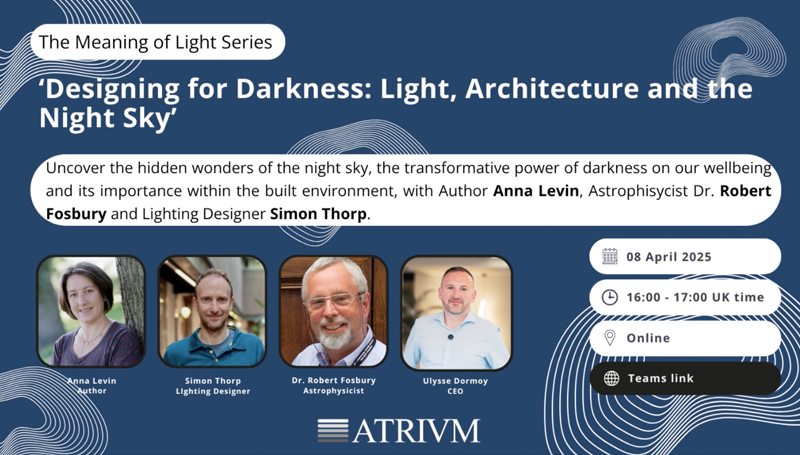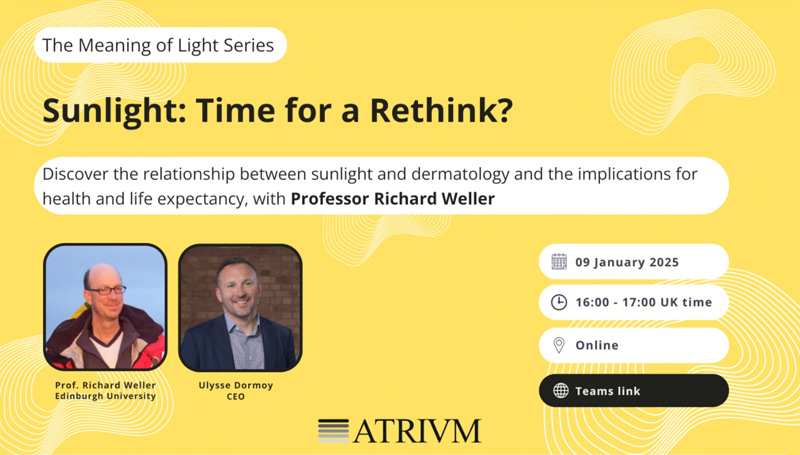Useful resources
Lectures on the book Physical Principles of Quantum Biology
with Nathan Sean Babcock
(2025)
An introduction to quantum biology
with Betony Adams
NITheCS (2025)
Dr Betony Adams presents this mini-school on quantum biology in four lectures. The lectures aim to bridge interdisciplinary gaps by introducing key concepts from both physics and biology, exploring a range of biological systems influenced by quantum effects, and concluding with detailed case studies on entangled neural activation and quantum tunnelling in viral infection.
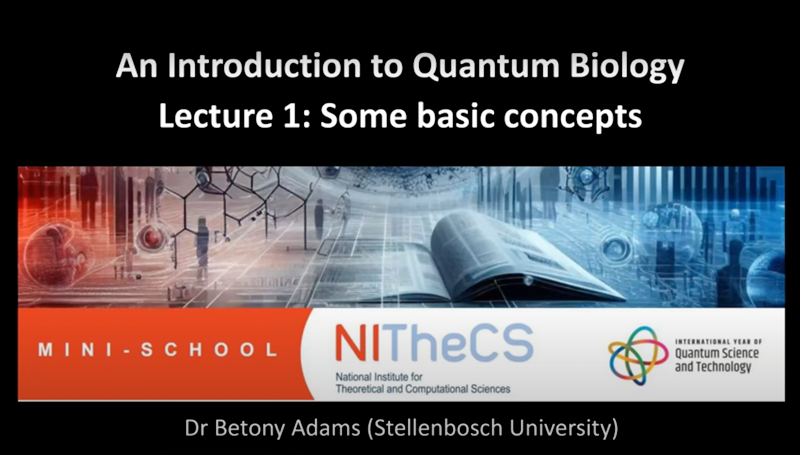
Physical Foundations of Quantum Biology
with Nathan Sean Babcock
(2024)
This scientific lecture was originally presented in October 2024 during a Big Quantum Biology Meeting hosted online by the QuBiT Lab at the University of California, Los Angeles (UCLA) and the Quantum Biology Doctoral Training Centre at the University of Surrey, England. The lecture provides a general introduction to the principles of quantum biology, an explanation of some of its founding assumptions concerning the so-called "trivial" nature of quantum effects in biology, and corrections to a few popular myths about quantum biology. The topics covered in this lecture include a brief history of quantum technologies, the physics of atoms and molecules, biological chromophores (pigments), the density functional theory (DFT) of molecular structure, challenges associated with simulating quantum effects in biomolecules, and prospects of using quantum computers to simulate quantum biology.

Quantum Biology
with Jim Al-Khalili
(2020)
How Quantum Biology Might Explain Life’s Biggest Questions
with Jim Al-Khalili
TEDTalks (2015)
How does a robin know to fly south? The answer might be weirder than you think: Quantum physics may be involved. Jim Al-Khalili rounds up the extremely new, extremely strange world of quantum biology, where something Einstein once called “spooky action at a distance” helps birds navigate, and quantum effects might explain the origin of life itself.
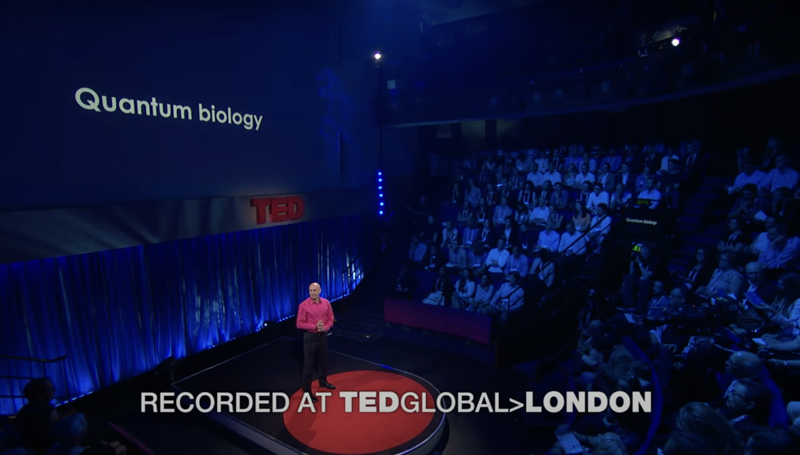
Quantum physics proposes a new way to study biology - and the results could revolutionize our understanding of how life works
by Clarice D. Aiello
The Conversation (2023)
Why nature is the ultimate quantum engineer
by Clarice D. Aiello
New Scientist (2023)
Quantum biology may help to solve some of life’s greatest mysteries
by Catherine Offord
The Scientist (2019)
The future of quantum biology
by Adriana Marais, Betony Adams, Andrew K. Ringsmuth, Marco Ferretti, J. Michael Gruber, Ruud Hendrikx, Maria Schuld, Samuel L. Smith, Ilya Sinayskiy, Tjaart P. J. Krüger, Francesco Petruccione and Rienk van Grondelle
J. R. Soc. Interface. (2018)
Biological systems are dynamical, constantly exchanging energy and matter with the environment in order to maintain the non-equilibrium state synonymous with living. Developments in observational techniques have allowed us to study biological dynamics on increasingly small scales. Such studies have revealed evidence of quantum mechanical effects, which cannot be accounted for by classical physics, in a range of biological processes. Quantum biology is the study of such processes, and here we provide an outline of the current state of the field, as well as insights into future directions.
The origins of quantum biology
by Johnjoe McFadden and Jim Al-Khalili
Proceedings of the Royal Society A (2018)
Quantum biology is usually considered to be a new discipline, arising from recent research that suggests that biological phenomena such as photosynthesis, enzyme catalysis, avian navigation or olfaction may not only operate within the bounds of classical physics but also make use of a number of the non-trivial features of quantum mechanics, such as coherence, tunnelling and, perhaps, entanglement. However, although the most significant findings have emerged in the past two decades, the roots of quantum biology go much deeper—to the quantum pioneers of the early twentieth century. We will argue that some of the insights provided by these pioneering physicists remain relevant to our understanding of quantum biology today.
Physics of life: The dawn of quantum biology
by Philip Ball
Nature (2011)
Physical Principles of Quantum Biology
by Nathan S. Babcock with Brandy N. Babcock
(2025)
Quantum Biology: A Glimpse into the Future of Medicine
by Geoffrey Guy
Profile Editions (2024)
A Worthwhile Medicine: How the world's first cannabis-based medication was approved
by Geoffrey Guy
Profile Editions (2021)
The Vital Question: Why is Life the Way it Is?
by Nick Lane
Profile Books Ltd (2015)
Life on the Edge: The Coming of Age of Quantum Biology
by Jim Al-Khalili and Johnjoe McFadden
Bantam Press (2014)
Quantum biology unlocking the mysteries of how life works
by Clarice D. Aiello
SciTechDaily (2023)
A Foresight Activity on Research in Quantum Biology (FarQBio)
Lead authors Luca Turin and Martin Plenio
European Science Foundation (2015)
Vibrations, quanta and biology
by S.F. Huelga and M.B. Plenio
Contemporary Physics (2013)
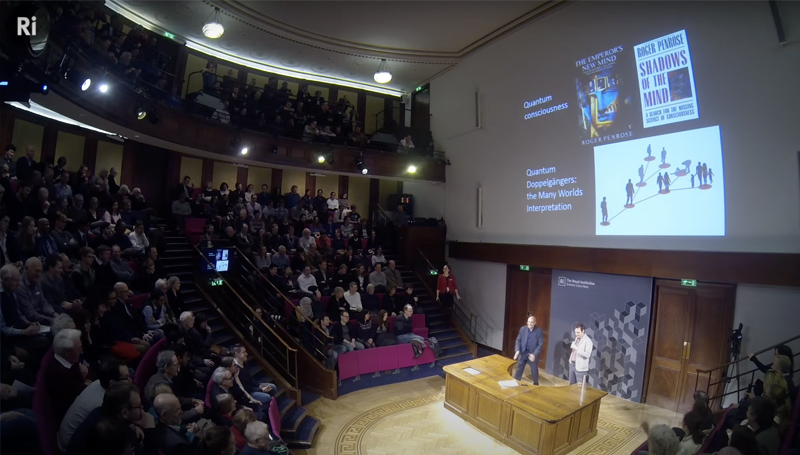
Jim Al-Khalili and Philip Ball answer questions on Quantum Biologv. What happens to electrons in tunneling atoms? Do molecules vibrate? How do quantum effects happen in complex biological systems?
Quantum biology explores how quantum effects influence biological processes, potentially leading to breakthroughs in medicine and biotechnology. Despite the assumption that quantum effects rapidly disappear in biological systems, research suggests these effects play a key role in physiological processes This opens up the possibility of manipulating these processes to create non-invasive, remote-controlled therapeutic devices. However, achieving this requires a nev interdisciplinary approach to scientific research.
Imagine using your cellphone to control the activity of your own cells to treat injuries and disease. It sounds like something from the imagination of an overly optimistic science fiction writer. But this may one day be a possibility through the emerging field of quantum biology.
Historically, researchers believed that quantum properties disappear at the scale of biology, but there is increasing evidence that this isn't the full story.
The key to practical quantum computing and high-efficiency solar cells may lie in the messy green world outside the physics lab, according to researchers at the Massachusetts Institute of Technology.
How bioelectricity could transform how we think about the body
with Sally Adee
TEDx Talks (2023)
Here are some things you don’t typically associate with electricity: eggs and sperm, their meeting to conceive, whether your injuries can heal, and cancer. But in the past few decades, new tools and new insights from across a range of scientific disciplines have made it clear that electricity is involved in all of these.

We Are Electric: The New Science of Our Body’s Electrome
by Sally Adee
Canongate Books Ltd (2023)
Open quantum systems theory of ultraweak ultraviolet photon emissions: Revisiting Gurwitsch's onion experiment as a prototype for quantum biology
by Nathan S. Babcock
Computational and Structural Biotechnology Journal (2024)
Biological autoluminescence as a perturbance-free method for monitoring oxidation in biosystems
by Petra Vahalová, Michal Cifra
Progress in Biophysics and Molecular Biology (2023)
Exosomes are released by bystander cells exposed to radiation-induced biophoton signals: Reconciling the mechanisms mediating the bystander effect
by Michelle Le, Cristian Fernandez-Palomo, Fiona E McNeill, Colin B Seymour, Andrew J Rainbow, Carmel E Mothersill
PLoS One (2017)
An observed effect of ultraviolet radiation emitted from beta-irradiated HaCaT cells upon non-beta-irradiated bystander cells
by Michelle Le, Fiona E McNeill, Colin Seymour, Andrew J Rainbow, Carmel E Mothersill
Radiat Res. (2015)
Ultra-weak photon emission from biological samples: definition, mechanisms, properties, detection and applications
by Michal Cifra and Pavel Pospíšil
J Photochem Photobiol B. (2014)
Properties of biophotons and their theoretical implications
by Fritz-Albert Popp
Indian J Exp Biol. (2003)
How migrating birds use quantum effects to navigate
by Peter J. Hore and Henrik Mouritsen
Scientific American (2022)
Low-intensity electromagnetic fields induce human cryptochrome to modulate intracellular reactive oxygen species
by Rachel M. Sherrard, Natalie Morellini, Nathalie Jourdan, Mohamed El-Esawi, Louis-David Arthaut, Christine Niessner, Francois Rouyer, Andre Klarsfeld, Mohamed Doulazmi, Jacques Witczak, Alain d'Harlingue, Jean Mariani, Ian Mclure, Carlos F. Martino, Margaret Ahmad
PLoS Biology (2018)
The Radical Pair Mechanism and the Avian Chemical Compass: Quantum Coherence and Entanglement
by Yiteng Zhang, Gennady P. Berman, Sabre Kais
arXiv (2015)
The Oysters That Knew What Time It Was
by Jo Marchant
Wired (2020)
The light of the mind
by Betony Adams and Francesco Petruccione
Physics World (2021)
Endogenous Electric Fields May Guide Neocortical Network Activity
by Flavio Fröhlich and David A. McCormick
Neuron (2011)
Keeping time: could quantum beating in microtubules be the basis for the neural synchrony related to consciousness?
by Travis J A Craddock 1 , Avner Priel, Jack A Tuszynski
J Integr Neurosci. (2014)
Consciousness in the universe: a review of the 'Orch OR' theory
by Stuart Hameroff and Roger Penrose
Phys Life Rev. (2014)
Why Does Consciousness Dissolve in Chloroform?
with Luca Turin
EMPAC @ Rensselae (2014)
Biophysicist Luca Turin explores the mysterious connection between time and human consciousness with this presentation of the many unusual discoveries from his research with general anesthesia and its effects on an internal sense of duration. With a rich combination of wit and scientific rigor, Turin explores one of the most enduring questions of human philosophy sprung from an investigation into one of our most common medical practices.

Quantum tunnelling makes DNA more unstable
by Lars Fischer & Gary Stix
Scientific American (2022)
How quantum mechanics lets us see, smell and touch
by Tim Folger
Discover (2018)
A quantum sense of smell
with Johnjoe McFadden and Jim Al-Khalili
Physics World (2015)
Molecular vibration-sensing component in human olfaction
by Simon Gane, Dimitris Georganakis, Klio Maniati, Manolis Vamvakias, Nikitas Ragoussis, Efthimios M. C. Skoulakis, Luca Turin
PLoS One (2013)
Interviews with Dr. Roger Seheult
YouTube Playlist
MedCram (2025)
Light does more than just illuminate — it influences how we feel, sleep, and function. Unpack IALD’s latest Whitepaper on the non-visual effects of light and explore the science, research, and practical design implications behind lighting that genuinely support human health and wellbeing, with Lighting Consultant Kevan Shaw.
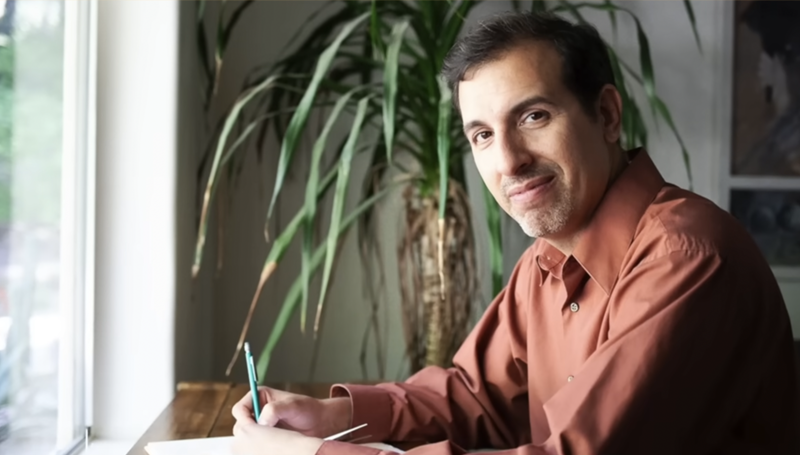
Lighting Beyond Vision: from Whitepaper to Practice
with Kevan Shaw and Ulysse Dormoy
ATRIUM (2025)
Light does more than just illuminate — it influences how we feel, sleep, and function. Unpack IALD’s latest Whitepaper on the non-visual effects of light and explore the science, research, and practical design implications behind lighting that genuinely support human health and wellbeing, with Lighting Consultant Kevan Shaw.

Beyond Vision & Photosynthesis - Why light matters to health and ageing both on earth and in space
with Professor Alistair Nunn and Professor Geoffrey Guy
ATRIUM (2025)
Explore the surprising parallels between the health challenges faced by astronauts in space and the risks we encounter in our modern indoor environments. Led by The Guy Foundation Professors Alistair Nunn and Geoffrey Guy, this event will discuss the impact of factors like microgravity, radiation, and light deprivation on human health, both in space and on Earth.

Designing for Darkness: Light, Architecture and the Night Sky
with Anna Levin, Robert Fosbury, and Simon Thorp
ATRIUM (2025)
Rise & Shine: Sunlight, Technology and Health
with Professor Simon Carter
ATRIUM THE MEANING OF LIGHT SERIES (2025)
Discover the complex interplay of scientific discoveries, social trends, and cultural values that have shaped our understanding of sunlight's role in human health and well-being throughout history. Delve into how our perception of sunlight has evolved over time and offer valuable insights into the ongoing debate surrounding sun exposure and human health with Open University Professor Simon Carter.

Light, Biological Rhythms and Architecture
with Prof. Russell Foster
ATRIUM THE MEANING OF LIGHT SERIES (2024)
The Infrared Revolution: New Frontiers in Light and Health
with Bob Fosbury and Glen Jeffery
ATRIUM THE MEANING OF LIGHT SERIES (2024)
Prepare to be amazed as we uncover the hidden power of light with UCL professors, astrophysicist Bob Fosbury and renowned expert in vision science, Glen Jeffery. Together, they will explore the revolutionary concept that light nourishes us from within. This event will challenge your understanding of light and its impact on our bodies and health.

Melatonin, Light & the Optics of the Human Body
with Scott Zimmerman
ATRIUM THE MEANING OF LIGHT SERIES (2024)
Prepare to be amazed as we uncover the hidden power of light with UCL professors, astrophysicist Bob Fosbury and renowned expert in vision science, Glen Jeffery. Together, they will explore the revolutionary concept that light nourishes us from within. This event will challenge your understanding of light and its impact on our bodies and health.
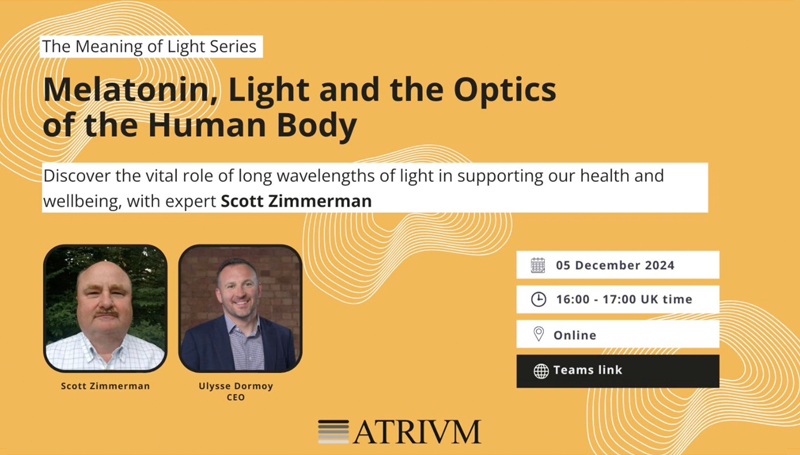
View The Guy Foundation YouTube Channel playlist: Mitochondria
Monitoring inflammatory, immune system mediators, and mitochondrial changes related to brain metabolism during space flight
by Darcy Tocci, Tomas Ducai, C. A. Barry Stoute, Gabrielle Hopkins, Mohammad G. Sabbir, Afshin Beheshti, Benedict C. Albensi
Frontiers in Immunology (2024)
In Our Time, Mitochondria
with Melvyn Bragg
BBC Radio 4 (2023)
Electron tunneling rates in respiratory complex I are tuned for efficient energy conversion
by Simon de Vries, Katerina Dörner, Marc J. F. Strampraad, Thorsten Friedrich
Angewandte Chemie International Edition (2015)
Quantum electron tunneling in respiratory complex I
by Tomoyuki Hayashi and Alexei A. Stuchebrukhov
Phys Chem B. (2011)
Increased mitochondrial respiration promotes survival from endoplasmic reticulum stress
by Jeffrey Knupp, Peter Arvan, Amy Chang
Cell Death Differ. (2019)
NADH Autofluorescence-A Marker on its Way to Boost Bioenergetic Research
by Patrick M Schaefer, Sviatlana Kalinina, Angelika Rueck, Christine A F von Arnim, Bjoern von Einem
Cytometry A. (2019)
Modulation of oxidative phosphorylation (OXPHOS) by radiation- induced biophotons
by Michelle Le, Fiona E McNeill, Colin B Seymour, Andrej Rusin, Kevin Diamond, Andrew J Rainbow, James Murphy, Carmel E Mothersill
Environ Res. (2018)
Emission of mitochondrial biophotons and their effect on electrical activity of membrane via microtubules
by Majid Rahnama, Jack A Tuszynski, István Bókkon, Michal Cifra, Peyman Sardar, Vahid Salari
J Integr Neurosci. (2011)
Electron tunneling chains of mitochondria
by Christopher C Moser, Tammer A Farid, Sarah E Chobot, P Leslie Dutton
Biochim Biophys Acta. (2006)
Studies of photosynthesis using a pulsed laser. I. Temperature dependence of cytochrome oxidation rate in chromatium. Evidence for tunneling
by D. DeVault and B. Chance
Biophys J. (1966)
Books
Origins of Life: The Primal Self-Organization
edited by Richard Egel, Dirk-Henner Lankenau, Armen Y. Mulkidjanian
Springer-Verlag (2011)
Life's utilization of B vitamins on early Earth
by D R Monteverde, L Gómez-Consarnau, C Suffridge, S A Sañudo-Wilhelmy
Geobiology (2017)
Quantum neurophysics: From non-living matter to quantum neurobiology and psychopathology
by Sultan Tarlacı and Massimo Pregnolato
Int J Psychophysiol. (2016)
Quantum Criticality at the Origin of Life
by Gabor Vattay, Dennis Salahub, Istvan Csabai, Ali Nassimi, Stuart A Kaufmann
arXiv (2016)
Quantum Biology on the Edge of Quantum Chaos
by Gabor Vattay, Stuart Kauffman, Samuli Niiranen
PLoS One (2014)
Quantum Tunnelling to the Origin and Evolution of Life
by Frank Trixler
Curr Org Chem. (2013)
Is photosynthesis quantum-ish?
by Philip Ball
Physics World (2018)
Vibronic origin of long-lived coherence in an artificial molecular light harvester
by James Lim, David Paleček, Felipe Caycedo-Soler, Craig N Lincoln, Javier Prior, Hans von Berlepsch, Susana F Huelga, Martin B Plenio, Donatas Zigmantas, Jürgen Hauer
Nature Communications (2015)
Photosynthetic light harvesting: excitons and coherence
by Francesca Fassioli, Rayomond Dinshaw, Paul C Arpin, Gregory D Scholes
J R Soc Interface (2013)
Optimization of photosynthesis by multiple metabolic pathways involving interorganelle interactions: resource sharing and ROS maintenance as the bases
by Bobba Sunil, Sai K Talla, Vetcha Aswani, Agepati S Raghavendra
Photosynth Res. (2013)
Evidence for wavelike energy transfer through quantum coherence in photosynthetic systems
by Gregory S Engel, Tessa R Calhoun, Elizabeth L Read, Tae-Kyu Ahn, Tomás Mancal, Yuan-Chung Cheng, Robert E Blankenship, Graham R Fleming
Nature (2007)
The adventures of physics Volume IV: The quantum of change
by Christoph Schiller
Motion Mountain (2021)
Quantum Mechanics (A Ladybird Expert Book)
by Jim Al-Khalili
Michael Joseph (2017)
30-Second Quantum Theory: The 50 most thought-provoking quantum concepts, each explained in half a minute
Edited by Brian Clegg
ICON Books (2014)
Computing with Quantum Cats
by John Gribbin
Transworld (2013)
How to Teach Quantum Physics to Your Dog
by Chad Orzel
Oneworld Publications (2010)

Alistair Nunn reviews Quantum 2.0: The Past, Present, and Future of Quantum Physics, by Paul Davies.
I was lucky enough to be sent an advanced reading copy of this book. In short, it is a must read. It is beautifully written, with a handy bibliography, and as much as it can in dealing with such a non-intuitive subject as quantum mechanics, is very accessible to a lay audience. The truth is that many shy away from the subject, not just because of the maths, but because the world of atoms, is well, weird!
Our normal ability to make sense of the macro world simply fails when applied to the micro world, especially when we consider the basics, such as wave-particle duality, entanglement, superposition, the uncertainty principle and our role as observers. The paradox here, of course, is that quantum mechanics is one of the most successful theories ever developed by humans, and even if we don’t fully understand the actual nature of the reality it seems to imply, we can apply it.
In this book, Paul takes the reader through the history of its origins, and how it was developed, and then onto how it has been applied, for instance, in understanding how our universe may have started, to developing standard computers and medical imaging. It implies that space is not empty. This earlier work has been described as quantum 1.0, but with the advent of quantum computing and the information age, and developments in medical devices and sensing, we are moving into quantum 2.0. But the catch continues to be that we still do not fully understand it, for instance, we are still trying to understand how we apply it to gravity. Indeed, Einstein always struggled with it – there are also several interpretations, such as the many worlds theory, or pilot wave theory, which attempt to explain it. Despite the fact that many brilliant minds have worked on it, there is still no real consensus on the nature of reality (yet!) it implies. Some even say it is unknowable. From the past to now, Paul then speculates on where we might be going with it, and critically, there is still a lot more to learn. There are also cautionary lessons here, especially, for instance, around artificial intelligence and what a quantum computer may be capable of, or somewhat scarily, become. As ever, science can be used for good, but also for bad. He also touches upon its role in biology: this has been difficult in the past, as we simply did not have the technology to more fully investigate it, but perhaps with quantum 2.0 this may change. Quantum mechanics has already revolutionised the world, but how much further is this revolution going to go? Will it lead to an ultimate understanding of reality? I suspect it might, but we have a way to go yet. My suspicion is that biology may be telling us as much about quantum mechanics as quantum mechanics is telling us about biology. When you have read this book, and I urge you to, perhaps you will also come to this conclusion, both practically, but also, maybe, existentially. How has the physics of our Universe led to beings that are conscious?
Enjoy.
Alistair Nunn
This review appeared in The Guy Foundation Quarterly Review 14: December 2025.
Paul Davies is a theoretical physicist, cosmologist and astrobiologist at Arizona State University and a prominent science communicator. As well as hundreds of research papers, he is a bestselling science author of over 30 books. His work spans quantum gravity, early-universe cosmology, quantum black holes and the nature of time, astrobiology (including the idea that life on Earth may have originated on Mars) and an evolutionary theory of cancer.

Robert (Bob) Fosbury reviews Scale: The Universal Laws of Growth, Innovation, Sustainability, and the Pace of Life in Organisms, Cities, Economies, and Companies , by Geoffrey West.
This book elevates the study of bioenergetics to its rightful place in the quest to understand what life is. Geoffrey West – a theoretical particle physicist who, in the late 1990s and early 2000s, formed a wonderfully creative interdisciplinary collaboration with the ecologists James Brown and Brian Enquist – describes the astonishing unity revealed by a theory of metabolism that extends across the biosphere, in both its biological and social dimensions.
Building on Max Kleiber’s 1930s discovery of a scaling law linking basal metabolic rate to body mass, based on measurements of a vast array of animals, this group developed a rigorous understanding of the mathematical form of the scaling law and its derivatives. They rooted it in the fractal properties of the distribution networks that sustain both plants and animals. By “seeing the forest for the trees”, the book allows us to perceive the complexity of life within a cosmological context.
In my study, it sits alongside Schrödinger’s What is Life, as a reminder of the fundamental importance of physics in biology.
This review appeared in The Guy Foundation Quarterly Review 13: September 2025.
Geoffrey West is based at the Santa Fe Institute, a world-leading centre for the science of complex systems. If you are interested in complexity theory they have a fascinating podcast, here is an episode featuring Geoffrey and his theory of scaling.

Anthony Finbow reviews Active Inference: The Free Energy Principle in Mind, Brain, and Behavior, by Thomas Parr, Giovanni Pezzulo, and Karl J. Friston.
Active Inference: The Free Energy Principle in Mind, Brain, and Behavior is the first detailed exposition of the active inference framework in print and a fascinating exploration of theoretical neuroscience. The work sets out by asking the question; How do living organisms persist while engaging in active exchanges with their environments? It posits that such organisms maintain their bodily integrity by minimising surprise, in perceiving their environment, through sensory observation and by exerting adaptive control on that environment.
The book describes the free energy principle (Friston 2009), whereby free energy is the measure of surprise or (more narrowly) prediction error between an internal model of the world and sensory inputs. Under active inference, perception and action are two complementary ways to minimise free energy; perception, by (Bayesian) belief updating to make observations compatible with sensory inputs and action, by changing the environment to make it more compatible with beliefs or goals. Furthermore, active inference hypothesises that rather than passively receiving information, organisms actively infer the causes of sensory data by continuously updating their internal models and, most important, taking actions that fulfil their predictions.
While the book is conceptually and technically rigorous, it balances this with accessibility, making it suitable for researchers across disciplines, from cognitive science and robotics to psychiatry and philosophy of mind. The book is essential reading for anyone interested in exploring how minds and brains work. It offers a powerful and thought-provoking framework for understanding life, cognition, and behaviour.
We are grateful to Thomas Parr, one of the authors, who recently introduced his work to The Guy Foundation.
This review appeared in The Guy Foundation Quarterly Review 12: June 2025.

Betony Adams reviews H2O: A Biography of Water, by Philip Ball.
Philip Ball’s book H2O: A Biography of Water was published over two decades ago and yet this sentence still holds true: ‘At first glance a simple molecule, water still offers up profound challenges to science’. Indeed, the more deeply water is investigated the more complex its properties appear. The book blends physics, chemistry, biology, and history, reaching as far back as the Big Bang and the very first physics of the Universe as it gave birth to the hydrogen so central to each molecule of water.
The book traces the cosmic and geological legacy of water on Earth before returning to the peculiarities of hydrogen, in particular the hydrogen bonding that lends water some of its interesting chemical properties. It is this element of the book that felt most relevant to our purposes, as the author examines the role that water plays in biology, and how the novel chemical properties of water may have facilitated the development and function of biological life.
The book is rigorously scientific, turning a clear eye on some of the pseudoscience that the study of water elicits. But, while I found the science fascinating, I also appreciated how the author was sensitive to the rich symbolic resonance of ‘life’s matrix’, the liquid that gives us our singular blue planet. In his own words: ‘We call our home Earth – but Water would be more apt’.
This review appeared in The Guy Foundation Quarterly Review 11: March 2025.

Betony Adams reviews Life as No One Knows It: The Physics of Life's Emergence, by Sara Imari Walker.
Of all the big unanswered questions in science, it is the mystery of life that most goes to the heart of human experience. What is life is a question that has intrigued some of the greatest minds in science, not least the founding figures of quantum mechanics, such as Schrodinger, who wrote a book about the subject. Sara Imari Walker’s recent book, Life as No One Knows It: The Physics of Life's Emergence, outlines the history and context of this question and the advances that have been made towards answering it.
Perhaps what makes life so difficult to explain is the lack of an accepted consensus on how we define life, and the book begins with a discussion of the various ways in which this definition has been attempted. Walker, a theoretical physicist and astrobiologist by training, then details the role that physics – which is arguably the most fundamental theory we have of the universe – might play in quantifying and understanding life. In particular she explains the principles of assembly theory, as a way to describe living systems.
Assembly theory, developed by Walker and fellow scientists, models the complexity of entities as a measure of how difficult it is, how many steps it takes, to assemble this entity from its fundamental constituent pieces. Walker goes on to explain how this approach to modelling living systems is not only experimentally testable but widens our ideas of what it means to be alive, from the confines of the biology we recognise on Earth, to what may be a far more universal phenomenon.
This review appeared in The Guy Foundation Quarterly Review 10: December 2024.
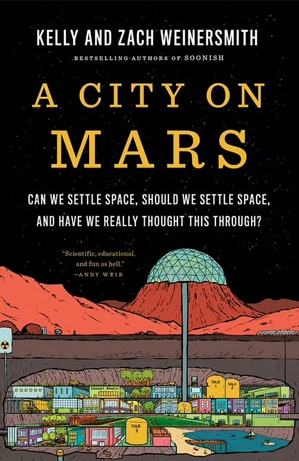
Alistair Nunn reviews A City on Mars: Can we settle space, should we settle space, and have we really thought this through? by Kelly and Zach Weinersmith.
The authors of the recent book A City on Mars: Can we settle space, should we settle space, and have we really thought this through? are a scientist and an illustrator, and this is a book you should read to cure you of any thought of trying to build a city on Mars, or even going there in the short term. It is well-researched and written, easy to read, and very funny in places, but with a serious message: mankind is not ready to build any kind of long-lasting outpost on Mars, especially if the reason is to try and save humanity.
It is a dream, and perhaps in the very long term, is feasible, but we are nowhere near ready for it at the moment. Something that perhaps Elon Musk has not quite understood. Even the authors, who are self-confessed space geeks, had to have a bit of rethink after they started doing the research. The reasons are multiple, ranging from our understanding of the health risks in space, which we know ourselves are far from complete, not helped because astronauts tend to be guarded about their health, the reliability of the technology, the importance of reproduction, the incomplete laws about who might own what in space – but perhaps the biggest, is that socially we, that is humans, have not learnt to even get along on Earth.
One of the big drivers of the colonisation idea is to protect our species in case of a catastrophe on Earth, but at the moment, until we learn to live in peace, it is entirely possible that trying to colonise space will increase the chances of such an event. History teaches us this. The other problem is that any colony will have to be entirely self-dependent, which means it will have to be very large, with well thought out laws, which of course, will have to evolve from those less effective ones that exist at the moment. In short, the consensus of the book is that until we have sorted out the laws, socially evolved, and have the technology to move a lot of people very quickly to Mars, safely, we have a long way to go.
Should we explore space? Certainly, as it is in our nature, but we need to do a lot more research and development, for instance, building a permanent base on the moon is a good idea, as it will give us time not just to work out the laws, politics and social side of things, but also the technology, and critically, how to keep people healthy. In summary, this is a thought provoking and entertaining read, and I would thoroughly recommend it to anyone interested in humanity’s future in space.
This review appeared in The Guy Foundation Quarterly Review 9: September 2024.
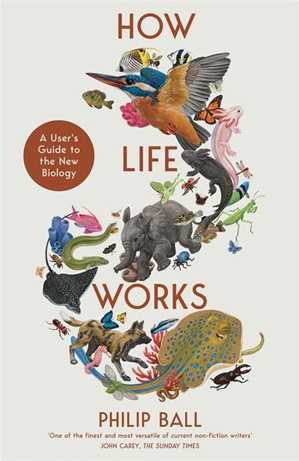
Betony Adams reviews How Life Works: A User’s Guide to the New Biology, by Philip Ball.
It has been two decades since the human genome was successfully sequenced. Philip Ball’s new book, How Life Works: A User’s Guide to the New Biology, opens with all the high excitement of an era in which a better understanding of our genetic machinery promised to unlock the mysterious animating force at the heart of living organisms. Our knowledge of the genome, however, hasn’t quite lived up to this promise. Advances in genetics have given us great insight into the importance of the materials – such as proteins – out of which life is built. But determining just how these blocks are assembled into living organisms remains frustratingly elusive.
The author drives this point home with a discussion of the COVID-19 pandemic. Despite all our medical knowledge, the progress of the disease in individual patients has proved difficult to predict. The book goes on to unravel the stranglehold that genes have on the biological imagination. Ball outlines the important role that DNA and proteins play while situating this within the wider framework of new ideas about just how flexible living organisms are within the bounds of their genetic expression. These new ideas include other ways in which biology manages and stores information, such as membrane potential, and Michael Levin’s research into bioelectricity and regeneration is referenced a number of times in the book. The author also addresses notions of agency in approaches to understanding life, where agency can imply a number of ideas, including the pursuit of goals.
Agency in the context of biology has become somewhat of a contentious term, Ball suggests, but to fully understand how life works the subject of agency, purpose, and intelligence will need to be addressed in a rigorous, scientific manner. Only then might we be able to fully answer the question that has puzzled physicists, biologists and philosophers alike: What is life?
This review appeared in The Guy Foundation Quarterly Review 8: June 2024.

Alistair Nunn reviews Exercised: Why Something We Never Evolved to Do Is Healthy and Rewarding, by Daniel E. Lieberman.
Daniel Lieberman is a widely published and acclaimed evolutionary biologist. He also does a lot of running, often barefoot. As part of his research, he has spent a lot of time studying hunter-gatherer groups, in particular, how they spend their days in relation to rest and physical activity, and how this may relate to health. The truth is that hunter-gatherers do tend to be much healthier than the average Westerner in that they suffer far less from “modern” diseases, such as diabetes, obesity and cardiovascular problems. Interestingly, although they do move a lot, they also spend a fair amount of time sitting, but critically, most of their physical activity is necessary, for instance, hunting and finding food, or carrying tools and other items. Their diet is also generally what modern doctors might define as “healthy”. What they don’t tend to do is formalised and structured exercise.
In this book the author makes the point that although we clearly need to move to remain healthy, we also, by nature, tend to resist it. The truth is that a Western lifestyle has made it very easy to be lazy, but this is perhaps, from an evolutionary perspective, entirely normal.
This is a well written and fascinating book that although fully referenced, is easily accessible to the lay reader. It provides considerable insight into why and how humans move, and how we are different from many other animals, and how this likely gave rise to our success as a species. Some of it is quite surprising. It also discusses some of the history of how physical activity has been perceived and portrayed over the years, and why, perhaps, we are now struggling with the concept that exercise is, indeed, one of the best medicines.
This review appeared in The Guy Foundation Newsletter 7: March 2024.

Betony Adams reviews The Human Cosmos: Civilization and the Stars, by Jo Marchant.
In The Human Cosmos: Civilization and the Stars, author Jo Marchant reflects, among other things, on the evolution and controversy of the field of chronobiology, as indicated above in the paper on circadian rhythms. Indeed, the term that has come to represent this area of research – circadian, meaning “about a day” – was first coined as an oblique insult aimed at the US biologist Frank Brown, who had rocked the field by suggesting that our internal clocks are in fact coupled to environmental cues, including gravitational fields. Marchant goes on to write:
"The disagreement reflected a deeper, philosophical split regarding the relationship that living creatures have with our planet and the wider cosmos. Are we autonomous, self-running machines, or is life in constant, subtle communication with the Earth, sun, moon, and even stars?"
Circadian rhythms are fundamentally important to the proper function of biological systems and human physiology. They can change how we respond to infection or medicine. Indeed, there is some evidence that the month in which we are born may affect our risk of diseases such as dementia, multiple sclerosis and schizophrenia. As we enter an era in which it is possible, for the first time in human history, to conceive of travelling to and settling on other planets, we need reminding that we are intimately coupled to the rhythms and conditions of the environment in which we evolved: the Earth. Marchant’s book eloquently describes the many ways in which this coupling unfolds, physiologically but also in our systems of meaning, the monuments and artworks that mark us out as uniquely human. We have looked towards – and wondered about – the sun and stars since we first began to question our place in the cosmos.
This reminder seems very timely in light of The Guy Foundation’s space health programme, which aims to tease out exactly how biology has adapted to its terrestrial environment and what this may mean for future space travel and settlement. Alongside the sense of wonder that these new horizons elicit are a number of critical questions that remain to be answered.
This review appeared in The Guy Foundation Newsletter 6: December 2023.

Betony Adams reviews Outlive: The Science and Art of Longevity, by Peter Attia.
In a recent Guy Foundation meeting with flight surgeon and astronaut Tom Marshburn, the conversation turned to the subject of space health research as a microcosm for understanding terrestrial ageing. Tom mentioned that The Guy Foundation might be interested in Peter Attia’s recent book, Outlive: The Science and Art of Longevity, which discusses the ways we might extend not just our lifespan, but also our healthspan. Many of the ideas expressed by Attia resonate strongly with The Guy Foundation’s own interests in the metabolic underpinnings of ageing and the ways in which a better understanding of these metabolic processes might be leveraged to achieve compressed mortality.
The notion of compressed mortality is central to Attia’s argument in the book. It is not enough to add extra decades to a human life, if those decades are spent in pain and illness. More importantly, we should aim at decreasing the years in which age renders us unable to enjoy life, not only adding years but adding worthwhile years. This is what Attia refers to as healthspan. In his opinion the practise of medicine needs a paradigm shift in how it frames health and disease. There have been two distinct eras in medical history, he argues: Medicine 1.0 which spans those centuries from the ancient world of Hippocrates until the advent of germ theory and the scientific method, and Medicine 2.0 which is still with us today.
Medicine 2.0 has made great strides in a number of contexts but despite these advances – and its success in treating acute disease – it has made, as the author puts it, scant progress against those diseases conventionally associated with old age. Attia refers to these as the Four Horsemen diseases: heart disease, cancer, neurodegenerative disease and type 2 diabetes and related metabolic dysfunction. In order to make progress against these diseases, he maintains we need a new way of thinking, a Medicine 3.0, which does not wait until the disease has manifested itself before intervention but rather practises proactive medicine, identifying risk factors years and even decades in advance and implementing a strategic response to these.
Outlive is an illuminating read on the agency we do have with respect to healthy ageing, despite our genetic lottery. Attia notes that, despite diabetes ranking behind the other Horsemen diseases as a leading cause of death, he believes it plays an underlying role in all of these diseases, which all show evidence of metabolic dysfunction. As we emerge from the acute phases of the COVID pandemic into a new era of chronic conditions such as long-COVID, a better understanding of how metabolism underpins, not only ageing, but disease in general, could see the consolidation of the era of Medicine 3.0.
This review appeared in The Guy Foundation Newsletter 5: September 2023.

Betony Adams reviews Entangled Life: How Fungi Make Our Worlds, Change Our Minds & Shape Our Futures by Merlin Sheldrake.
The secret lives and special properties of fungi are a topic of growing interest. In the March Newsletter we reported that Foundation research collaborators Philip Kurian, Founding Director of the Quantum Biology Laboratory at Howard University and Mike Levin, Distinguished Professor of Biology, Director of the Tufts Center for Regenerative and Developmental Biology, had been awarded an Alfred P. Sloan Foundation Matter-to-Life grant to investigate problem-solving behaviour in syncytial slime moulds.
While the animal and plant kingdoms have generated substantial research, fungi, at least in the opinion of mycologist and author Merlin Sheldrake, have been to some extent neglected. His recent book Entangled Life: How fungi make our worlds, change our minds and shape our futures addresses the question in exquisite detail. In the context of these fascinating organisms, we are still somewhat in the dark. This is to a degree literal, and Sheldrake describes how the visible signs of fungi above ground – the moulds and the mushrooms – are complemented by the vast filamentous networks of underground mycelia.
Despite their relative obscurity, fungi are essential to life as we recognise it. In the barren environments of the early Earth, fungi led the way: breaking down rock into soil; supplying root-like systems before plants evolved their own. Without fungi, we would be buried beneath the weight of the dead. They are masters of decomposition, even offering potential solutions for the toxic waste – nuclear, oil, plastic – that is the long shadow cast by human advancement. Their role in the discovery of antibiotics changed the face of modern medicine. They are even implicated in our more everyday pleasures. In his vivid description of an episode of truffle hunting, the author elaborates on the language of volatile compounds that fungi use to communicate and to seduce the noses of both animals and humans.
Sheldrake’s fungal interests span numerous scientific disciplines, even touching on questions of consciousness. Intelligence is almost exclusively attributed to humankind. But what of the ability that fungal networks demonstrate to communicate information – at least in part by electrical signals reminiscent of neural activation potentials – and to store this information – in a manner that looks a lot like memory. Indeed, while optimisation problems can be computationally expensive, researchers have found that fungi can solve network questions such as the travelling salesman problem remarkably efficiently. There are also the intriguing ways in which they can hijack the agency of other species, and the Zombie-ant fungus is a particularly disturbing example of this. Fungi are – quite literally – mind bending, their production of psychedelic compounds such as psylocibin offering a new way to think about – and treat – the mind and its disorders.
But their propensity for revelation is not merely chemical. The example they hold up – their incredible resourcefulness – offers new ways in which to imagine our own conflicted relationship with resources. Sheldrake sketches out a different idea of what it means to be alive, an idea that recognises the power of relationships and the entangled lives of all living organisms. In a world that seems increasingly skewed towards the needs and desires of a single species, this is a compelling metaphor.
This review appeared in The Guy Foundation Newsletter 4: June 2023.
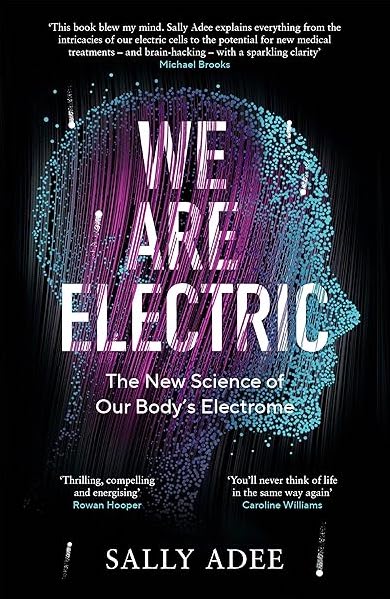
Professor Alistair Nunn, The Guy Foundation’s Director of Science, reviews We are Electric: The New Science of Our Body's Electrome by Sally Adee.
Sally Adee’s interest in the world of biological electricity began when she experienced a transcranial direct current stimulation (tDCS) technique aimed at enhancing people’s ability to become sharp shooters. While immersed in a virtual reality set up, her ability dramatically improved. The experience spurred her to investigate the world of bioelectricity. The result is this book, which delves into the deep history and speculates on the eventual future of bioelectricity and suggests that understanding the “electrome” could play a pivotal role in the evolution of medicine.
Overall, this is a very well written book, with an easy style that should enable any reader to engage in the subject and learn something. It is not a deep scientific treatise on the subject, but it is referenced, and cites many of the main sources of literature. It is also clear that the author has taken the time to talk to some of the leading scientists in the area, such as Mike Levin.
What this book does very well is to discuss the main protagonists in history and explain how the concepts fell in an out of favour. For instance, the battle between Volta and Luigi Galvani in the 18th Century, and whether the newly discovered electricity should be viewed from the point of view of physics or biology – it all shows how good ideas can sometimes backfire when pushed too hard, risking the subject becoming viewed as quackery. Alas, this is something that is still very much evident today, resulting in some fields taking many years to come back “in vogue”. Indeed, this particular battle between physicists and biologists about the role of electricity in biology was repeated both in the 19th and 20th Centuries and was made worse by discoveries in genetics and pharmacology, which tended to draw the focus away from bioelectricity. But in the 21st Century, as the author suggests, the importance of bioelectricity is being revisited with new vigour.
The book skips over the work of some key players such as Alexander Gurwitsch, who introduced the concept of the morphogenetic field in the 1920s, and Robert Becker – who pioneered research into regeneration and electricity in the middle part of the 20th Century. Important contributions to the understanding of bio-electromagnetism have also been made by scientists such as Herbert Fröhlich and Jiři Porkorný and others, such as Nick Lane, have discussed why we are electric beings in the first place and how this may have arisen. Although it could be argued the contributions of these pioneers may have been at a deeper level than the target audience of the book, one wonders if a mention would have been helpful in pointing the reader towards the world of quantum biology.
The final chapter is perhaps the most thought provoking, as it may well encourage the reader to view things differently – and this would apply both to the lay and the professional scientific reader. As Mike Levin says, we need to stop thinking about genetics as determining body shape, but instead think about the morphogenetic field and the bioelectric code it may contain. The key here is that there is now a lot of evidence to suggest that it is ion channels, and gap junctions, that are playing a central role in generating these morphogenetic fields. Taking this a step further, it therefore suggests that any drug that modulates these channels is thus altering the morphogenetic field, to either harmful or helpful effect. It is also interesting that many anaesthetics alter ion channel function, which might tell us something about the nature of consciousness.
In summary, this is a book that is definitely worth reading, for both the lay person and the more focussed researcher in search of a better understanding of the history of this field. From the scientific perspective, it reinforces the simple fact that life is all about the dissipation of energy and that structure emerges from the movement of fundamental particles, such as electrons and protons, which of course means fields must be involved. From a personal perspective, this book highlights a gap in our knowledge, and perhaps a way of thinking and a scientific approach, as it has not addressed the relationship between role of electricity in life and how it is powered. We evolved from prokaryotes, who in turn, evolved from abiotic conditions on the early earth: understanding this could well help explain the origins of bioelectricity itself.
This review appeared in The Guy Foundation Newsletter 3: March 2023.
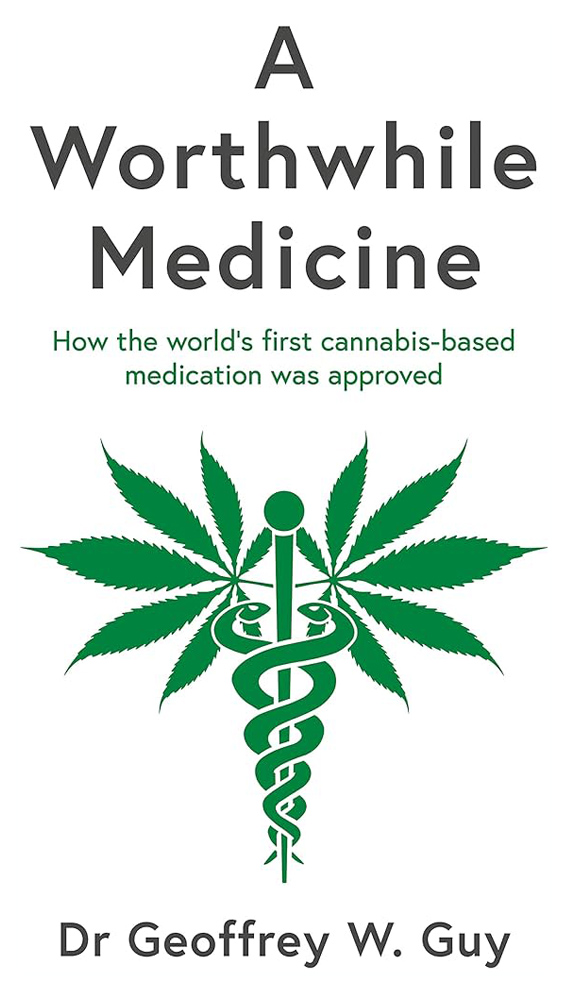
Dr Nathan Babcock, postdoctoral researcher, Quantum Biology Lab at Howard University, sent us the following review of A Worthwhile Medicine: How the world's first cannabis-based medication was approved, by Dr Geoffrey W. Guy.
A Worthwhile Medicine is more than a worthwhile read
Geoffrey W. Guy’s account of the creation of the world’s first licensed cannabis-based medicine is compelling and engrossing: Combining personal memoir with professional commentary and socioeconomic saga, the story weaves diverse elements into a cohesive narrative that offers the reader a unique chance to watch history unfold. Yet this epic speaks for itself. Rather than promoting the book with glowing reviews designed to entice the buyer, the dust cover’s inside jacket grabs the reader's attention with real news headlines that chronicle GW Pharmaceuticals’ precipitous rise to the top.
Beginning with the chapter Listening to Patients, the book’s main theme is the critical importance of listening to clients and shareholders in earnest and with compassion, revealing insight into Prof. Guy’s success as a doctor, an entrepreneur, and a storyteller. In classic style, the prose is littered with adages and witticisms to boost the acumen of both business leaders and philosophers alike, laying out the course of one doctor’s life starting with hospital practice before leaping to industry and pharmaceutical research specifically, until one twist of fate led him to a half-day event at the Royal Pharmaceutical Society about the medical use of cannabis. The rest, they say, was history.
Readers interested in the intricacies of building a multi-billion dollar business while navigating political pitfalls and regulatory red tape will find this to be a riveting read. Yet what captures the imagination is the synthesis of the author’s lifetime of experience with pharmaceuticals into the conviction that present-day pharmaceutical science is inadequate to describe the action of many common drugs. Combining this conviction with the audacity to bet his fortune on the science of the future, Prof. Guy leaves no doubt that his story is still history in the making.
The final chapter on Quantum Biology offers more questions than
answers, which The Guy Foundation aims to unveil. Much research on quantum biology has focused on the search for quantum coherence and non-trivial dynamical effects in biological systems. While this focus has great academic merit, The Guy Foundation unabashedly seeks to develop this new science into therapeutic practice. Will it hold the secret to quantum medicine? Prof. Guy surely aims to find out.
This review appeared in The Guy Foundation Newsletter 2: December 2022.
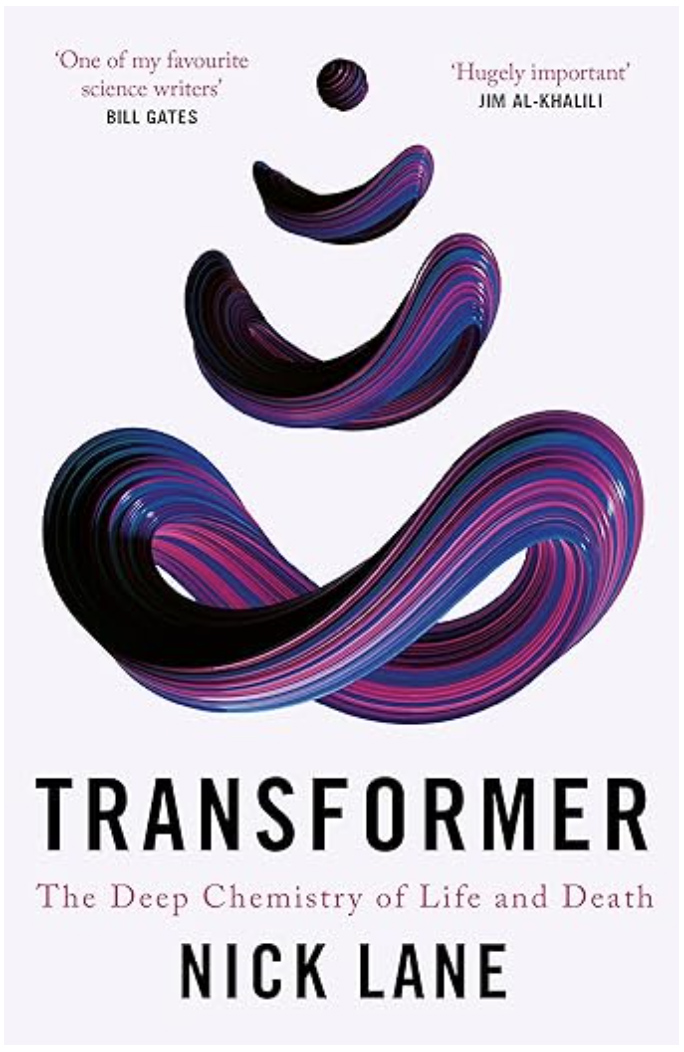
The Guy Foundation has long been interested in Professor Nick Lane’s research into mitochondria and the biochemistry of living systems, inviting him to give one of the first presentations for the online lecture series, in Autumn 2020. We are very pleased to see that he has written a new book, published in July, entitled Transformer: The Deep Chemistry of Life and Death.
As Professor Alistair Nunn put it:
“The book is – most simply and profoundly – about a fundamental biochemical process known as the Krebs cycle and what this means for the development of life on Earth. It is an easily digestible and informative read for both a scientific and non-scientific reader alike. Critically, it outlines a deep simplicity to the animating cycle of energy and matter that constitutes living organisms, which links the origins of life to ageing and perhaps, consciousness itself.”
This review appeared in The Guy Foundation Newsletter 1: September 2022.
Calabrese, V., C. Cornelius, A. T. nkova-Kostova, I. Iavicoli, Paola R. Di, A. Koverech, S. Cuzzocrea, E. Rizzarelli, and E. J. Calabrese. 2012. 'Cellular stress responses, hormetic phytochemicals and vitagenes in aging and longevity', Biochim.Biophys.Acta, 1822: 753-83. (link)
Cifra, M., and P. Pospisil. 2014. 'Ultra-weak photon emission from biological samples: definition, mechanisms, properties, detection and applications', J Photochem Photobiol B, 139: 2-10. (link)
Craddock, T. J., D. Friesen, J. Mane, S. Hameroff, and J. A. Tuszynski. 2014. 'The feasibility of coherent energy transfer in microtubules', J R Soc Interface, 11: 20140677. (link)
Cuadrado, S., J. R. Goicoechea, J. Cernicharo, A. Fuente, J. Pety, and B. Tercero. 2017. 'Complex organic molecules in strongly UV-irradiated gas', Astron Astrophys, 603. (link)
Gatenby, R. A., and B. R. Frieden. 2010. 'Coulomb interactions between cytoplasmic electric fields and phosphorylated messenger proteins optimize information flow in cells', PLoS One, 5: e12084. (link)
Imai, S. I., and L. Guarente. 2016. 'It takes two to tango: NAD+ and sirtuins in aging/longevity control', NPJ Aging Mech Dis, 2: 16017. (link)
Kosgodage, U. S., R. Mould, A. B. Henley, A. V. Nunn, G. W. Guy, E. L. Thomas, J. M. Inal, J. D. Bell, and S. Lange. 2018. 'Cannabidiol (CBD) Is a Novel Inhibitor for Exosome and Microvesicle (EMV) Release in Cancer', Front Pharmacol, 9: 889. (link)
Kosgodage, U. S., P. Uysal-Onganer, A. MacLatchy, R. Mould, A. V. Nunn, G. W. Guy, I. Kraev, N. P. Chatterton, E. L. Thomas, J. M. Inal, J. D. Bell, and S. Lange. 2019. 'Cannabidiol Affects Extracellular Vesicle Release, miR21 and miR126, and Reduces Prohibitin Protein in Glioblastoma Multiforme Cells', Transl Oncol, 12: 513-22. (link)
Kurian, P., T. O. Obisesan, and T. J. A. Craddock. 2017. 'Oxidative species-induced excitonic transport in tubulin aromatic networks: Potential implications for neurodegenerative disease', J Photochem Photobiol B, 175: 109-24. (link)
Le, M., F. E. McNeill, C. B. Seymour, A. Rusin, K. Diamond, A. J. Rainbow, J. Murphy, and C. E. Mothersill. 2018. 'Modulation of oxidative phosphorylation (OXPHOS) by radiation- induced biophotons', Environ Res, 163: 80-87. (link)
Levin, M. 2014. 'Molecular bioelectricity: how endogenous voltage potentials control cell behavior and instruct pattern regulation in vivo', Mol Biol Cell, 25: 3835-50. (link)
Lovley, D. R., and N. S. Malvankar. 2015. 'Seeing is believing: novel imaging techniques help clarify microbial nanowire structure and function', Environ Microbiol, 17: 2209-15. (link)
Lundholm, I.V.; Rodilla, H.: Wahlgren, W.Y.; Duelli, A.; Bourenkov, G.; Vukusic, J.; Friedman, R.; Stake, J.; Scheider, T.; and Katona, G. 2015. 'Terahertz radiation induces non-thermal structural changes associated with Frohlich condensation in a protein crystal', Structural Dynamics, 2, 054702. (link)
Nunn, A. V., G.W. Guy, and J.D. Bell. 2016. 'The quantum mitochondrion and optimal health', Biochem Soc Trans, 44: 1101-10. (link)
Pokorny, J., J. Pokorny, and J. Kobilkova. 2013. 'Postulates on electromagnetic activity in biological systems and cancer', Integr Biol (Camb), 5: 1439-46. (link)
Schmied, R., J. D. Bancal, B. Allard, M. Fadel, V. Scarani, P. Treutlein, and N. Sangouard. 2016. 'Bell correlations in a Bose-Einstein condensate', Science, 352: 441-4. (link)
Srobar, F. 2012. 'Frohlich systems in cellular physiology', Prague Med Rep, 113: 95-104. (link)
Stratton, D., S. Lange, and J. M. Inal. 2013. 'Pulsed extremely low-frequency magnetic fields stimulate microvesicle release from human monocytic leukaemia cells', Biochem Biophys Res Commun, 430: 470-5. (link)
Sweetlove, L. J., A. Lytovchenko, M. Morgan, A. Nunes-Nesi, N. L. Taylor, C. J. Baxter, I. Eickmeier, and A. R. Fernie. 2006. 'Mitochondrial uncoupling protein is required for efficient photosynthesis', Proc Natl Acad Sci U S A, 103: 19587-92. (link)
Tachibana, S., A. Kouchi, T. Hama, Y. Oba, L. Piani, I. Sugawara, Y. Endo, H. Hidaka, Y. Kimura, K. I. Murata, H. Yurimoto, and N. Watanabe. 2017. 'Liquid-like behavior of UV-irradiated interstellar ice analog at low temperatures', Sci Adv, 3: eaao2538. (link)
Tamulis, A., and M. Grigalavicius. 2014. 'Quantum entanglement in photoactive prebiotic systems', Syst Synth Biol, 8: 117-40. (link)
Tapia, P. C. 2006. 'Sublethal mitochondrial stress with an attendant stoichiometric augmentation of reactive oxygen species may precipitate many of the beneficial alterations in cellular physiology produced by caloric restriction, intermittent fasting, exercise and dietary phytonutrients: "Mitohormesis" for health and vitality', Med.Hypotheses, 66: 832-43. (link)
Weber, S., E. Ohmes, M. C. Thurnauer, J. R. Norris, and G. Kothe. 1995. 'Light-generated nuclear quantum beats: a signature of photosynthesis', Proc Natl Acad Sci U S A, 92: 7789-93. (link)
Winkler, J. R., and H. B. Gray. 2014. 'Long-range electron tunneling', J Am Chem Soc, 136: 2930-9. (link)


